
R. Zobl, D. Fuchshuber, R. Kersting, R. Hoffmann, C. Rauch, L. Hvozdara, G. Strasser, K. Unterrainer, E. Gornik
Institute of Solid State Electronics &
Center of Microstructure Research (MISZ), Techn. Univ. Vienna
A-1040 Vienna, Austria
THz emission from two different types of quantum well structures is reported. A novel combination of a stepped quantum well with a resonant injector and extractor is used to generate far infrared emission by excitation of instable plasma oscillations. The observed radiation is weak. Parabolically graded quantum wells were studied in two other sets of experiments. By putting the well in a 90° tilted position into a magnetic field a spectral shift of the emission by about 20 cm-1 is observed. Optical excitation of a similar parabolic well with ultrafast laser pulses enables one to investigate the dynamic response of the 2DEG in the well. The frequency of the emitted THz radiation at room temperature is around 50 cm-1. A minimal increase of the frequency with excitation density is observed.
Introduction
Plasma effects are of special interest for FIR generation since the plasma frequency of free carriers in semiconductors usually is in the terahertz region. On one hand strong electroluminescence in the FIR region from a parabolic quantum well was recently demonstrated [1] whereas on the other hand the excitation of rising coherent oscillations in gaseous plasmas is a well known effect. In solids, however, these instable coherent modes are in strong competition with ordinary incoherent plasma oscillations and even more with thermal relaxation processes of the carriers so that the effect is not clearly identified in solids so far. To investigate various plasma effects two different sample types were prepared: a wide parabolic quantum well (PQW) and a stepped quantum well structure (G205). Time resolved experiments on parabolic quantum wells are explained in detail in section 6.
Plasma Oscillations
Parabolically Graded Quantum Well Potentials
One of the interesting features of parabolically confined potentials is that they absorb and emit radiation only at the bare harmonic oscillator frequency w 0, independent of the number of electrons in the well This is in accordance with Kohn’s theorem [2] which states that cyclotron resonance absorption is unaffected by electron-electron interaction. The similar property of the intersubband emission in parabolic quantum wells (PQW) is attributed to the formation of an electron slab in the well and a deformation of the selfconsistent potential to rectangular shape, thus exactly canceling out the depolarization shift normally observed in 2D wells.
Theory of Plasma Instabilities
Monoenergetic current flow in collisionless gas plasmas excites oscillations. If the dispersion relation of these oscillations is complex, Im(w ) > 0 leads to exponentially growing plasma waves. A necessary condition for their self startup is a locally inversion of the carrier distribution in momentum space. This perturbation of the normal Maxwell-Boltzmann distribution must exhibit at least two maxima (Penrose criterion). Quantum mechanically the process is a particle-plasmon interaction [3]. Relaxation of single carriers by a direct transfer of energy into the plasma mode is only possible above a certain threshold so that high current injection is needed. This in turn leads to severe problems with heating and the effect can easily be wiped out by interaction with phonons. Careful sample design in form of small mesas is mandatory for this reason.
Sample Structures
Band structures of both samples are shown in Fig. 1 and Fig. 2 .

Fig. 1: Band structure of a wide parabolic quantum well (PQW).
The PQW consists of a single graded GaAs/AlGaAs quantum well grown on a semiinsulating substrate. On both sides of the well the barriers are modulation doped. The well is nominally 200 nm wide resulting in a bare oscillator frequency of 50 cm-1. The sample has two annealed Au/Ge/Ni top contacts and a 20 µm period grating for outcoupling of the spontaneous terahertz emission. The net emissive area is 5x5 mm2. Simple heating of the electron gas by lateral current injection is used to populate higher energy levels and to induce radiative downward transitions. There is no deformation of the potential shape through the lateral biasing.
To excite instable plasma modes in a 2DEG a stepped quantum well structure was fabricated. Electrons are injected selectively through a thin barrier into the upper miniband in the well. Due to the extension of this miniband in the wide area of the well the level spacing is small compared to the intermediate miniband in the narrow well region. The energy separation of the upper and the lowest miniband is matched to the LO phonon energy in GaAs. This in combination with a resonant extractor formed by two thin barriers leads to an effective depopulation of the intermediate levels while the upper and lower minibands are strongly populated by current injection and phonon assisted downward transitions, respectively. To minimize overheating effects the sample is designed as small mesas with annealed grating couplers on top which also act as top contacts. Between the grating metallization the highly doped regions are etched away to reduce self absorption.
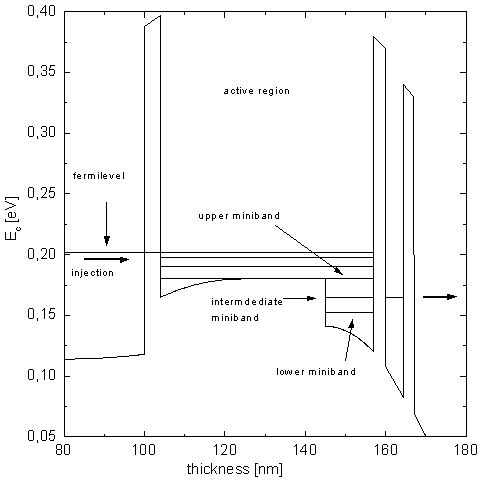
Fig. 2: Band structure of the stepped quantum well G205.
Measurements
All measurements were performed at 4,2 K in liquid helium. A triple set of photoconductive detectors is sitting in the center of a 7 T superconducting magnet at the lower end of the cryostat. One p-Ge broadband detector and two magnetically tunable frequency selective detectors (GaAs, InSb) cover the spectral range from 30 cm-1 to 300 cm-1. Radiation from the samples is guided to the detectors via a metallic light pipe.
For magnetic field dependent measurements the PQW was placed in the center of an upper magnet (up to 5 T). Two different sample orientations in the magnetic field were used as shown in Fig. 3 and Fig. 4 (see also Fig. 6).
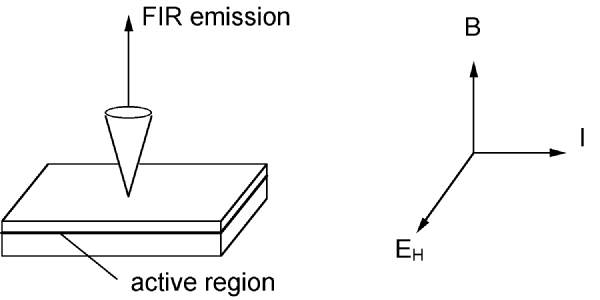
Fig. 3: Standard orientation of current flow I, magnetic field B and Hall field EH for measurement of the parabolic quantum well in magnetic fields. Due to the sample geometry no Hall field is established in this arrangement. The grating on top of the sample is not shown.
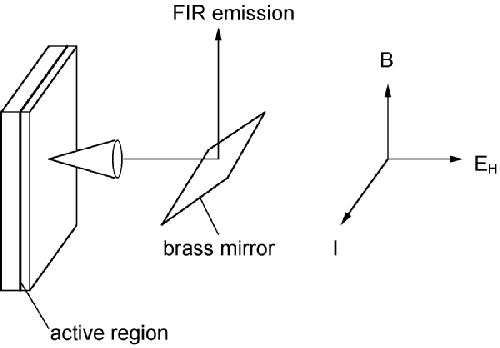
Fig. 4: Measurement of the PQW in a 90° tilted position. In this orientation the Hall field is strong. The outcoupling grating again is not shown.
On both sample types measurements were performed by applying pulses of several volts and several µs duration. A repetition rate of 23 kHz gave a duty cycle of 10 % to 20 %.
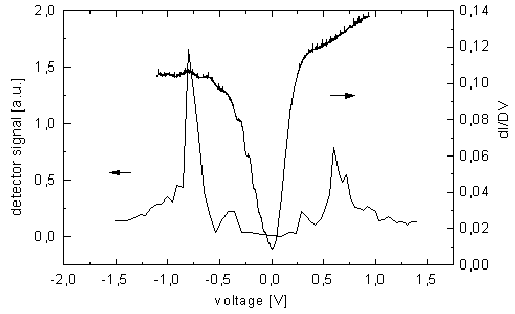
Fig. 5: Integral emission intensity of G205 with the GaAs detector. Also shown is the derivative of the I-V curve.
Figure 5 shows the measured broadband signal of sample G205 vs. applied voltage. Also shown is the derivative of the I-V. The change in the slope of the derivative coincides with two maxima in the emission, indicating the onset of a growing plasma mode in a narrow regime around 700 mV.
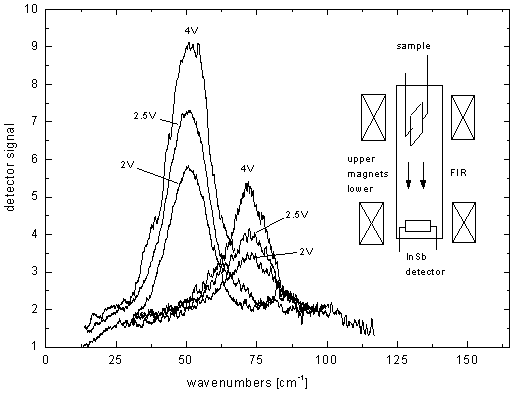
Fig. 6: Spectral shift of the Emission for a 90° tilted position of the PQW in the magnetic field.
To investigate the effect of a magnetic field on the FIR emission of the PQW magnetic fields up to 5 T were applied. For a magnetic field direction perpendicular to the layers no CR emission can be observed while the normal intersubband emission almost immediately vanishes even at low magnetic fields. If the magnetic field is applied parallel to the well but perpendicular to the direction of current flow (Fig. 6) CR emission again is not seen whereas a frequency shift of the intersubband radiation is observed starting at magnetic field strengths above 2 T. The shift is attributed to the formation of a strong electric field perpendicular to the well via Hall effect. At 4 T the center frequency of the FIR emission has moved from 50 cm-1 to 70 cm-1 accompanied by a decrease in signal intensity of 50 %. The shifted center frequency position is still independent from the laterally applied electric field and the current flow.
Conclusions for the Electroluminescence Experiments
For the sample G205 the formation of an instable plasma oscillation under vertical injection was demonstrated. The emitted FIR radiation was either too weak or outside the reach of the spectrally resolving detectors, a problem which can be overcome by simple increasing the number of emitters and switching to other detectors respectively. On the other hand the PQW shows a strong signal. So while the carrier distribution in a parabolic well cannot be inverted by itself a combination of the excellent oscillatory behavior of the PQW with resonant vertical injection through barriers seems promising. Adding a superlattice within the parabolic potential could create a gap between the energy levels of the well giving way to the formation of a growing plasma mode. However as the magnetic field measurements show, care must be taken that the symmetry of the structure is not affected for instance by the bias voltage which would lead to a breakdown of the Kohn theorem.
Few-Cycle THz Emission from Intersubband Plasmon Oscillation in Parabolic Wells
Few-cycle THz emission is observed from semiconductors excited by ultrafast laser pulses. The investigation of this THz emission is important for the understanding of the underlying carrier dynamics as well as for possible applications in spectroscopy and imaging. The emission is explained by coherent charge oscillations if the laser pulse generates a superposition within the subbands of a heterostructure, or by the instantaneous polarization and by the subsequent motion of photoexcited carriers in a depletion or in a built-in field of a semiconductor.
During the investigation of the ultrafast field screening on p-i-n structures in pump and probe experiments oscillations of the built-in field due to plasma oscillations of the photo generated carriers were observed [4]. We have performed THz emission experiments in such structures and have observed emission due to coherent plasma oscillations. In addition, we have also found that the screening of the surface field by the optical excited carriers induces plasma oscillations of cold electrons beyond the depletion zone of the n-doped epilayers. The plasma oscillations of cold electrons are characterized by a long damping time which leads to a very efficient emission process [5].
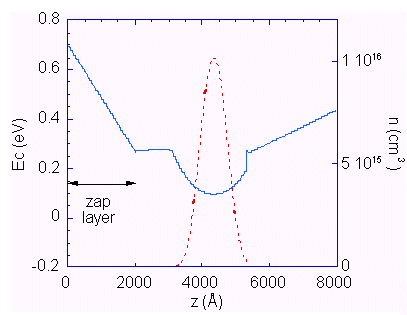
Fig. 7: Schematic band diagram of the parabolic well and of the top GaAs layer for photoexcitation.
In order to improve the THz emission and to investigate the dynamic response of a quasi two-dimensional electron gas we have designed a structure with a parabolic well just beyond the depletion zone of a n-doped GaAs cap layer (Fig. 7). From electrons in modulation doped wells we expect much longer damping times. According to Kohn’s theorem the electrons in parabolically confined potentials will interact with light only at the bare harmonic oscillator frequency ![]() (D is the depth of the parabolic potential, L the width, and m* the effective mass) independent of the carrier concentration in the well. The parabolic well was designed to be 2000 Å wide and to have a resonance frequency w0 of about 1.5 THz. The structure was modulation doped to give an electron concentration in the well of about 5×1011 cm-2. The design is similar to the one used in the previous explained electroluminescence setup. In experiments on a similar parabolic well where the electrons where heated by a lateral current spontaneous THz emission was observed at the expected resonance position [1].
(D is the depth of the parabolic potential, L the width, and m* the effective mass) independent of the carrier concentration in the well. The parabolic well was designed to be 2000 Å wide and to have a resonance frequency w0 of about 1.5 THz. The structure was modulation doped to give an electron concentration in the well of about 5×1011 cm-2. The design is similar to the one used in the previous explained electroluminescence setup. In experiments on a similar parabolic well where the electrons where heated by a lateral current spontaneous THz emission was observed at the expected resonance position [1].
The optical excited experiments were performed using a mode-locked Ti:Sapphire laser emitting 100 fs pulses at 800 nm. A 4.2 K bolometer is used to detect the THz radiation. Time resolution is achieved by focusing two delayed pulses on the samples and by recording the time integrated THz auto correlation signal as a function of the delay time.
We have observed coherent THz emission from the parabolic well sample at room temperature. The auto correlation signal and the Fourier transformed spectra are shown in Fig. 8 and Fig. 9 for different excitation densities. Clear oscillations are visible with a damping time corresponding to the DC mobility of the quasi two-dimensional channel. The observed frequency is around 1.5 THz. According to Kohn’s theorem we do not expect a dependence of the emission frequency on the carrier excitation density. However, we observe a small increase of the frequency with excitation density which we suppose is due to filling of the parabolic well by photoexcited carriers.
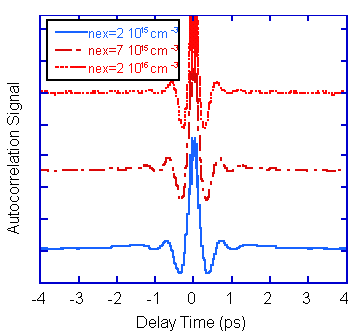
Fig. 8: Auto correlation of the THz emission from the parabolic well.

Fig. 9: Fourier transformed spectra of the optical excited THz emission from the parabolic well.
Acknowledgments
We acknowledge financial support by the Austrian Science Foundation (FWF, START Y47) and by the US Army Research Office.
References
[1] K. D. Maranowski, A. C. Gossard, K. Unterrainer, E. Gornik: "Far-infrared Emission from Parabolically Graded Quantum Wells", Appl. Phys. Lett., Vol. 69, No. 23, 1996, p. 3522 – 3524.
[2] W. Kohn: "Cyclotron Resonance and de Haas-van Alphen Oscillations of an Interacting Electron Gas", Phys. Rev., Vol. 123, No. 4, 1961, p. 1242 – 1244.
[3] P. Bakshi, K. Kempa: "Current Driven Plasma Instabilities in Lower Dimensional Systems", Superlatt. Microstruct., Vol. 17, No. 4, 1995, p. 363 – 372.
[4] W. Shah, A. L. Smirl, W. F. Tseng: "Coherent Plasma Oscillations in Bulk Semiconductors", Phys. Rev. Lett., Vol. 74, No. 21, 1995, p. 4273 – 4276.
[5] R. Kersting, K. Unterrainer, G. Strasser, E. Gornik, H. F. Kauffmann: "Few -cycle THz emission from cold plasma oscillations", Phys. Rev. Lett. , 79, 3038 (1997).
Project Information
Project Manager
Dr. Karl Unterrainer
Institut für Festkörperelektronik, Technische Universität Wien
Project Group
|
Last Name |
First Name |
Status |
Remarks |
|
Fuchshuber |
David |
student |
|
|
Gornik |
Erich |
university professor |
|
|
Hoffmann |
Rainer |
student |
|
|
Hvozdara |
Lubos |
dissertation |
|
|
Kersting |
Roland |
postdoc |
|
|
Rauch |
Christoph |
dissertation |
|
|
Strasser |
Gottfried |
assistant professor |
|
|
Unterrainer |
Karl |
assistant professor |
|
|
Zobl |
Reinhard |
dissertation |
Publications in Reviewed Journals
Presentations
Cooperations